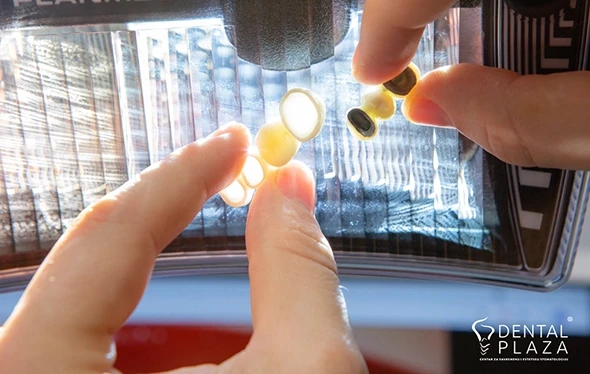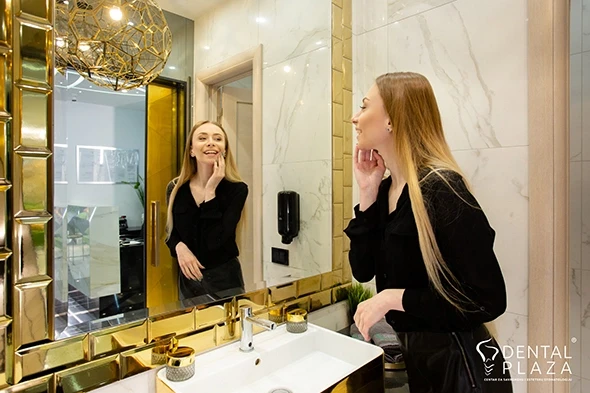Do not be shy, show your teeth!
Call Center 08-21h
Do not be shy, show your teeth!
Call Center 08-21h
.webp)
Metal-ceramic crowns, as the word itself says, basically have metal, and layers of ceramics are applied over it. Ceramic is durable, so it is a suitable material for reshaping shapes, but also for bringing color to perfection and harmony. These crowns have always been in the forefront in the modern history of dentistry. They are added to the greater prevalence by the fact that they are older and that they are much more often chosen as the default value. Most crowns of this type serve as a functional tooth, but they also fit aesthetically into existing teeth.
Metal-ceramic crowns do not have a limited lifespan, but since your tooth is under each crown, the condition of the tooth can change over time, which sometimes requires replacement of the crown itself.
The advantage of metal-ceramic crowns in relation to metal-free ones is certainly their price. They are more economical and much cheaper than metal-free ones, and they give very good aesthetic results. Their disadvantage is that some people may be allergic to metals, and in some cases there is the formation of gray gums around the crown due to oxidation of the metal, which is not the case with metal-free crowns.
Metal-ceramic dental crowns give very satisfactory results if done adequately. Sometimes there may be a difference between these crowns and a natural tooth, because the metal is non-transparent. In that case, we sometimes advise patients to make metal-free crowns.
Metal-free crowns are currently the highest level of dental prosthetics, because in addition to functionality and mechanical properties, they meet the highest standards when it comes to aesthetics. These crowns transmit light, so their appearance is much more natural than with metal-ceramic ones.
Metal dental crowns do not transmit light well due to the metal base and can often show their flaw when a dark metal color appears on the edge of the tooth and gums. This is perhaps the biggest drawback when it comes to metal crowns.

Although it is a very resistant material, cracking of metal-ceramic crowns can occur in cases of bruxism in patients. The forces that occur when gnashing teeth during the night are too great and act in unfavorable directions. Then there is usually a rupture, and after that during the day, with a little force, the cracked part can break off. In that case, contact your dentist who will offer you an adequate solution.
In our clinic, you get a 5-year guarantee on crowns.
Due to the oxidation of the metal in contact with the saliva, the gums may be discolored along the edge of the crown.
Metal dental crowns do not have a specific lifespan, but over time, changes in oral structures occur, which makes them inadequate and that is when they must be replaced. Proper maintenance of oral hygiene and regular visits to the dentist will improve the longevity of work.
The procedure of removing metal-ceramic crowns is simple and completely painless.
Metal-ceramic crowns are made in the dental technique, and in order to make them, it is necessary to grind the tooth and take an impression. Based on the impression, a model of brushed teeth is cast, on which the technician later models crowns. The base of the crown is made of metal, and the rest of the standard ceramics, which allows a great combination of aesthetics and strength.

As they are made on the patient's teeth, metal-ceramic crowns can also be made on implants.
Due to the stable chemical structure, the color of metal-ceramic crowns does not change over time.
The ceramics that represent the surface layer of these crowns exists in several different colors, so the color of the finished crowns can be adjusted to the patient's wishes. The shape of the crown is also something that can be adjusted to the requirements of each patient.
In our clinic, the price of a metal-ceramic crown on a tooth is 100e, and on an implant 120e.

Do you have questions?
.webp)
Metal-ceramic crowns, as the word itself says, basically have metal, and layers of ceramics are applied over it. Ceramic is durable, so it is a suitable material for reshaping shapes, but also for bringing color to perfection and harmony. These crowns have always been in the forefront in the modern history of dentistry. They are added to the greater prevalence by the fact that they are older and that they are much more often chosen as the default value. Most crowns of this type serve as a functional tooth, but they also fit aesthetically into existing teeth.
Metal-ceramic crowns do not have a limited lifespan, but since your tooth is under each crown, the condition of the tooth can change over time, which sometimes requires replacement of the crown itself.
The advantage of metal-ceramic crowns in relation to metal-free ones is certainly their price. They are more economical and much cheaper than metal-free ones, and they give very good aesthetic results. Their disadvantage is that some people may be allergic to metals, and in some cases there is the formation of gray gums around the crown due to oxidation of the metal, which is not the case with metal-free crowns.
Metal-ceramic dental crowns give very satisfactory results if done adequately. Sometimes there may be a difference between these crowns and a natural tooth, because the metal is non-transparent. In that case, we sometimes advise patients to make metal-free crowns.
Metal-free crowns are currently the highest level of dental prosthetics, because in addition to functionality and mechanical properties, they meet the highest standards when it comes to aesthetics. These crowns transmit light, so their appearance is much more natural than with metal-ceramic ones.
Metal dental crowns do not transmit light well due to the metal base and can often show their flaw when a dark metal color appears on the edge of the tooth and gums. This is perhaps the biggest drawback when it comes to metal crowns.

Although it is a very resistant material, cracking of metal-ceramic crowns can occur in cases of bruxism in patients. The forces that occur when gnashing teeth during the night are too great and act in unfavorable directions. Then there is usually a rupture, and after that during the day, with a little force, the cracked part can break off. In that case, contact your dentist who will offer you an adequate solution.
In our clinic, you get a 5-year guarantee on crowns.
Due to the oxidation of the metal in contact with the saliva, the gums may be discolored along the edge of the crown.
Metal dental crowns do not have a specific lifespan, but over time, changes in oral structures occur, which makes them inadequate and that is when they must be replaced. Proper maintenance of oral hygiene and regular visits to the dentist will improve the longevity of work.
The procedure of removing metal-ceramic crowns is simple and completely painless.
Metal-ceramic crowns are made in the dental technique, and in order to make them, it is necessary to grind the tooth and take an impression. Based on the impression, a model of brushed teeth is cast, on which the technician later models crowns. The base of the crown is made of metal, and the rest of the standard ceramics, which allows a great combination of aesthetics and strength.

As they are made on the patient's teeth, metal-ceramic crowns can also be made on implants.
Due to the stable chemical structure, the color of metal-ceramic crowns does not change over time.
The ceramics that represent the surface layer of these crowns exists in several different colors, so the color of the finished crowns can be adjusted to the patient's wishes. The shape of the crown is also something that can be adjusted to the requirements of each patient.
In our clinic, the price of a metal-ceramic crown on a tooth is 100e, and on an implant 120e.
